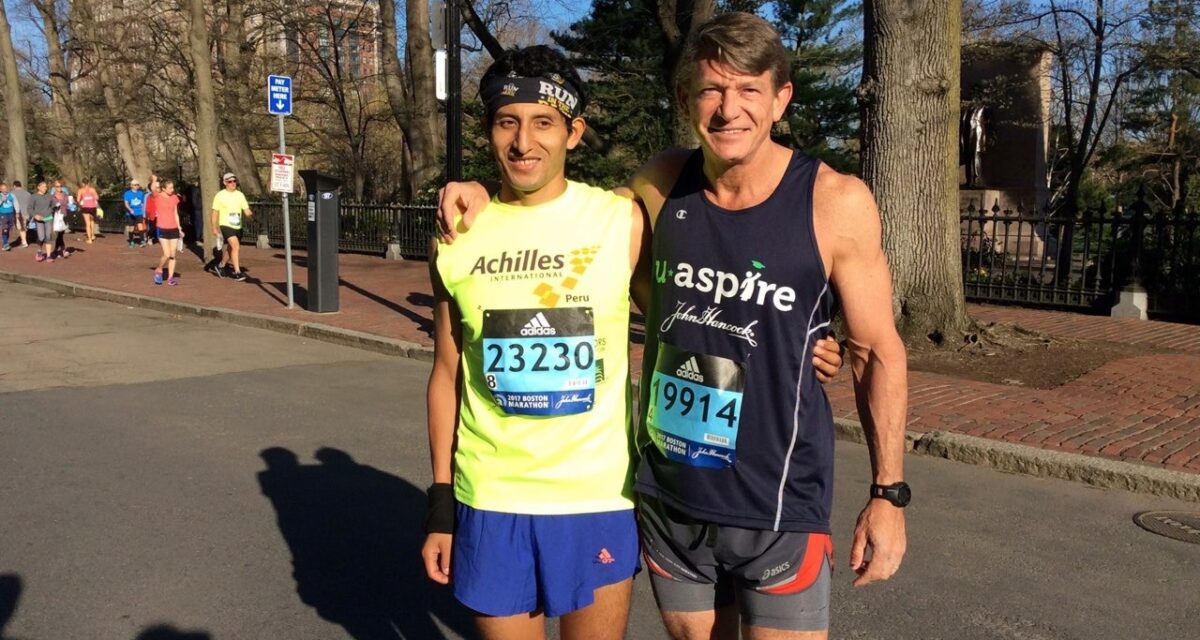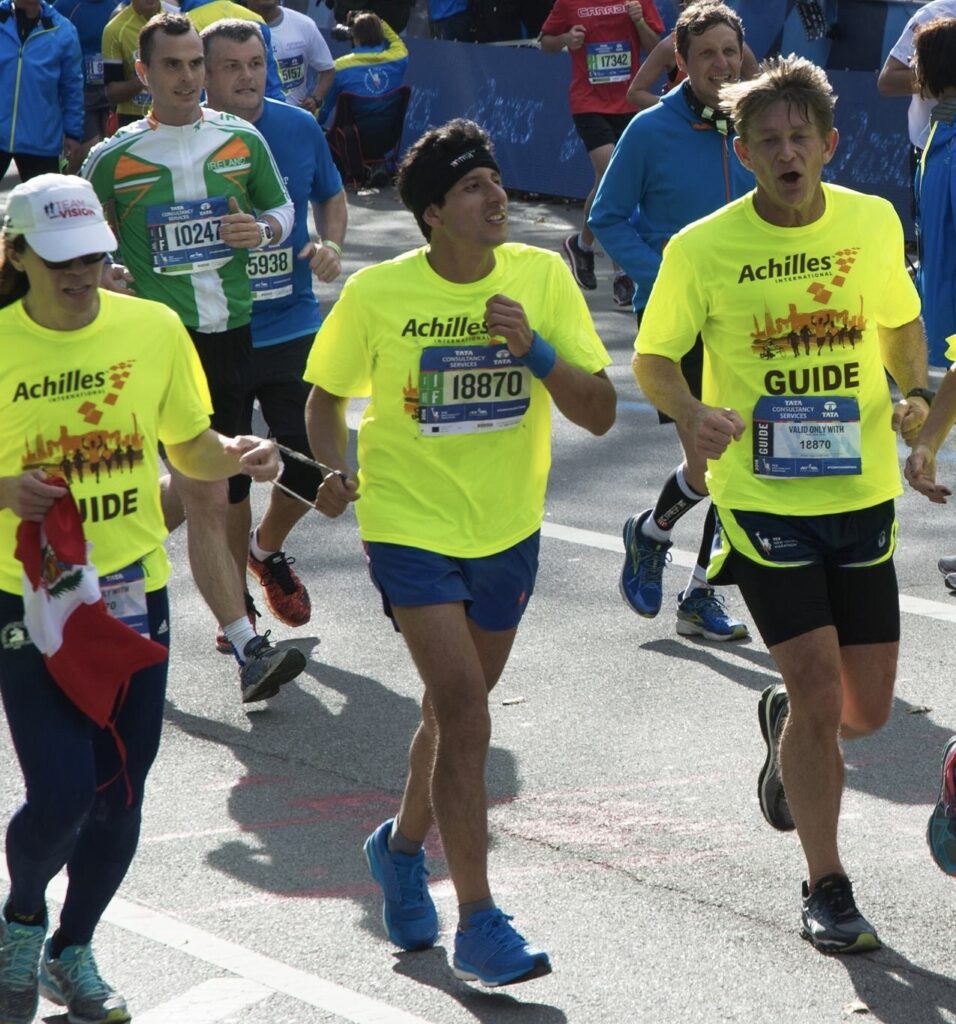
By: Randy Boyd
Hugo has a vision. He dreams of running. Fast. He dreams of running fast enough to make the Peruvian National Team for Athletes with Disabilities. He dreams of going to a university and getting a degree. If he can make the national team, then he can get a scholarship to go to college. That is his vision. That is his dream.
Hugo Estrada was born in the Peruvian jungle 31 years ago on a farm where his father grows cocoa and coffee. Growing up with his eight siblings, he enjoyed walking and running back from school. But it was not an idyllic rural setting. It was during the time when communist revolutionaries, known as the Shining Path, terrorized the countryside. At age 12, Hugo developed Retinitis Pigmentosa and began to gradually go blind.

Peruvian culture isn’t kind to the blind. Often children are put in boarding schools for blind children, but the schools are not free. Thus, parents often drop them off, pay for two months boarding in advance, and never come back for them. The school then turns them out in the street. Hugo was fortunate to be able to stay with his family, but they were not very supportive otherwise. He left the jungle for Lima, the capital, three years ago and was incredibly fortunate to meet Claudia, his girlfriend, and together they are making a life in their one-room apartment (bathrooms are communal). Determined to get the education that was interrupted in the jungle, he hopes to earn the equivalent of a high school diploma next year. He has already earned a certificate in therapy and works at a spa. In his spare time, he makes crafts for extra money. Between grants and gifts, he was able to make the trip to New York, his first time on a plane and his first time leaving Peru.
I’ve run 31 marathons, and this trip made nine New York City marathons in a row. Every year I would either pass or be passed by Team Achilles, an organization that guides Athletes With Disabilities (AWD). I signed up to run with Achilles and I got matched with Hugo.
Vincent Lau, an ophthalmologist of Vietnamese descent living in Los Angeles has guided in six other races. Lau and I were paired with Hugo. Claudia emailed us beforehand that his target was 3:55, which is a very serious goal for a first marathon. We met Hugo in person for the first time on Saturday before the race and learned that while he did his first half marathon in August, his longest training run was only 18 miles. This was disconcerting! Vincent and I developed a strategy with him, with Claudia as our translator. In spite of his goal, we assured him the most important objective of his first marathon was to finish and have fun, but we would try to put him in a position to achieve his goal. We would start out running 8:30 miles for the first 13 miles, making sure we had the strength to have a strong second half. It’s common for first-time marathoners to start off too fast. Hugo agreed with the plan.
On race day, Hugo was quiet but confident. He speaks no English and Vincent and I very little Spanish, but enough to guide us. There are usually three guides, with two out front to clear a path through the 55,000 runners and one tethered to the runner. It’s hard to recruit volunteers thus for Hugo, it was just Vincent and I. Vincent agreed to be the one tethered to Hugo, Vincent’s right arm to Hugo’s left. I was the “rabbit,” in charge leading them by running about five meters ahead, setting the pace, clearing traffic, and fetching water for them at the water stations. It’s a busy job!
One of the fun parts about the New York City Marathon is that it is so diverse, with on average 130 countries represented. In years past I recall guides yelling “make way, a blind runner coming through” and I would move to the right or left to let them pass. That part of guiding shouldn’t be too much of a problem, I thought. Within the first quarter mile, I realized I was wrong! The downside to having such an international field is that many runners didn’t speak English! For the next 26 miles, I would yell, push, point, and whatever I could think of to clear a path for the two runners trailing me running side by side. I found just bumping people were very efficient.
It was also a new experience trying to set a pace for someone else. Rather than running at a pace I felt was right for me, I had a set pace, one a bit slower than I was used to, that I had a lot of responsibility to stay on precisely. The entire race my head was on a swivel, looking at my watch, then looking behind me to see Vincent and Hugo staying with me, to making sure Hugo looked ok, that no one was cutting in front of them, then back to looking ahead. Water stations are very crowded and people bump into each other a lot. It’s not a safe place for the blind runners to go, so my other job was to fall back, get their orders, sprint ahead, and grab either water or Gatorade depending on their order, take it to them, sprint back to get some for me and then back ahead of them again.
By mile 18 we had reached Hugo’s furthest he had ever run, and both Vincent and I began to monitor him more closely. We would ask him, “Como Esta?” to which he would always reply “Bueno,” but we would study his stride, his breathing, and his arms to make sure he was really ok. Though he began to walk the water stations by mile 20, he remained strong.
It was hard work and took a lot of planning and strategy, but it is far, far more rewarding running and winning for someone else. And we did! Hugo was awesome! By mile 24 we knew were going to make it, and by mile 25 we knew we would make his goal. I think I had a big smile on my face, with maybe a few happy tears, the entire last mile to the finish line. Hugo never stopped and finished strong, beating his goal by 32 seconds: 3:54:28!
Hugo inspired Vincent and me with his determination and his passion. It is so easy to make excuses, and Hugo could use living in poverty, his blindness or so many other obstacles, but he was determined to overcome everyone. Any excuse I might come up with for not running on a particular day or running a race pales in comparison. He also taught us that vision is also an ideal, not just a physical attribute. Begin with a dream, then develop a plan by having very concrete metrics to measure your progress, like running your first marathon in 3:55. Dream it, plan it, and do it. No excuses. Thank you, Hugo. May you continue to achieve your dreams and inspire others!